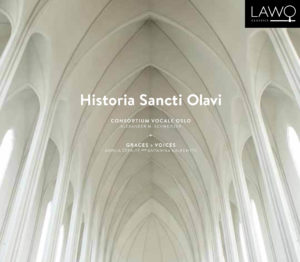«The two ensembles alternate duties most comfortably, especially in the extended Matins. There are detailed liner notes tracing the history of both cult and music. Absorbing and very spiritual.»
Agora Classica “Choir and organ” review by Brian Morton
«It is wonderful to hear the simple liturgical recitative of the readings juxtaposed in proper liturgical order with the musically appealing antiphons and responsories. […]
The results are rather beautiful, even quite ethereal. The singing is well paced, speeding and slowing to follow the natural cadence of the text and music. The singers are so together that it is impossible to discern individual voices.»
Loewen – American record guide
«Immaculately sung and atmospherically recorded, this two-disc set of pure chant includes, for those with a historical bent, fascinating sleevenotes.»
JP – BBC Music Magazine review
Norsk musikkhistorie (in Norwegian)
«Consortium Vocale Oslo og Graces & Voices presenterer en unik plate. […] Og det er en særdeles vakker innspilling – som henter inn den eldgamle atmosfæren og som lytter så er opplevelse meget god, da plateselskapet også har valgt å gi denne platen ut i Surround 5.0. Har man den minste interesse for tidligmusikk, så er denne platen å anbefale!»
Trond Erikson – Den klassiske CD-bloggen
English translation:
Norwegian music history:
«Consortium Vocale Oslo and Graces & Voices presents a unique CD. […] And it is an exceptionally beautiful recording – which collects the ancient atmosphere and as a listener the experience is outstanding, the record company has also chosen to give this disc out in Surround 5.0. If you have the slightest interest in early music, then this disc is highly recommended! »
«The importance of a production like this cannot be overstated. The performances are outstanding: the legato singing of men and women is perfect and completely natural. The solo contributions of members of the Consortium Vocale Oslo are very good. The text is always clearly audible. The production also deserves an A: the booklet includes much historical, musical and liturgical information in a clearly intelligible English translation. […] If you are interested in liturgical music, and especially in plainchant, this is a production not to be missed.»
Johan van Veen – MusicWeb International, jan. 2017
Prisverdig
«Utførelsen har en forbilledlig energi og fremdrift, som kjennetegner god gregoriansk syngemåte. Meget homogent […] Kort sagt: En strålende dokumentasjon av et viktig stykke norsk kirke- og kulturhistorie.»
Helge Landmark – Vårt Land, 14.03.17
English translation:
Praiseworthy:
«The performance has a remarkable energy and momentum, the characteristics of good Gregorian sing manner. Very homogenous […] In short: A brilliant documentation of an important piece of Norwegian Church and Cultural History.»
«This is highly recommended as an outstanding presentation of a late Medieval liturgical Office.»
J. F. Weber – Fanfare Magazine, april 2017
Núria Serra – Sonograma magazine (Catalan)
English summary:
«In Oslo, we have received a musical jewel. This is the “Historia
Sancti Olavi “a cultural treasure of medieval Norway Lawo Classics presents for the first
time.[…] We are confident that this album will be a source of joy and inspiration to many listeners who value the theological and spiritual dimension Gregorian repertoire»
Norsk Kirkemusikk no. 4/2017
English summary:
“…. It is thus from a cultural historic view a very important job Consortium Vocale Oslo and Graces & Voices has done here. In addition, the artistic result is very good. Both ensembles are very homogenic and good, in addition to the professionalism being well taken care of by the conductors musical and hymnological skills ….. “”
Ronald E. Grames, Issue 40:6 (July/Aug 2017) of Fanfare Magazine.
This is a recording of a significant portion of the most important Medieval Norwegian musical document extant, the chants of the divine office for the celebration of the feast of St. Olaf on 29 July.
…Both ensembles sing with remarkable technical perfection and unanimity, like a single voice, shifting in scope and timbre as solo cantors sing, or smaller groups emerge.
….this is an engrossing experience for anyone interested in Medieval chant, or in the early history of the Christian church and its liturgies

